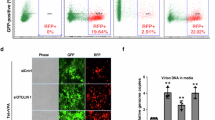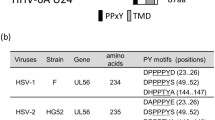Abstract
Bovine infected-cell protein 0 (BICP0) encoded by bovine herpes virus 1 (BHV-1) immediate early gene is necessary for efficient productive infection, in a large part, because it activates all 3 classes of BHV-1 genes. It also has the ability to efficiently transactivate promoters that are not derived from BHV-1. To investigate the mechanism by which BICP0 achieves these effects, we expressed and purified BICP0 and its different mutants in E. coli. In vitro assays showed that both full-length BICP0 and its isolated RING finger domain induce the accumulation of polyubiquitin chains. Mutations within the RING finger region that abolish the in vitro ubiquitination activity also cause severe reductions in BICP0 activity in other assays. Based on these, we conclude that BICP0 has the potential to act as an E3 ubiquitin ligase during viral infection and its RING finger domain is necessary for this function. These strongly support the hypothesis that BICP0 might influence virus infection through its ability to interact with the ubiquitin-proteasome pathway.
Similar content being viewed by others
References
Jones, C, Alphaherpesvirus latency: its role in disease and survival of the virus in nature, Advances in Virus Research, 1998, 51: 81–133.
Everett, R. D., Preston, C. M., Stow, N. D., Functional and Genetic Analysis of the Role of Vmwll0 in Herpes Simplex Virus Replication, Herpesvirus Transcription and Its Regulation (ed. Wagner, E. K.), Fla.: CRC Press, 1991, 49–76.
Halford, W. P., Schaffer, P. A., ICP0 is required for efficient reactivation of herpes simplex virus type 1 from neuronal latency, J. Virol., 2001, 75: 3240–3249.
Inman, M., Zhang, Y. G., Geiser, V. et al., The zinc ring finger in the bICP0 protein encoded by bovine herpesvirus-1 mediates toxicity and activates productive infection, Journal of General Virology, 2001, 82:483–492.
Freemont, P. S., RING for destruction? Curr. Biol., 2000, 10: R84-R87.
Joazeiro, C. A., Weissman, A. M., RING finger proteins: mediators of ubiquitin ligase activity, Cell, 2000, 102: 549–552.
Pickart, C. M., Mechanisms underlying ubiquitination, Annu. Rev. Biochem., 2001, 70: 503–533.
Sambrook, J., Russell, D. W., Molecular Cloning: A Laboratory Manual, 3rd ed,. New York: Cold Spring Harbor Laboratory Press, 2002.
Deng, L., Wang, C, Spencer, E. et al., Activation of the IkB kinase complex by TRAF6 requires a dimeric ubiquitin-conjugating enzyme complex and a unique polyubiquitin chain, Cell, 2000, 103: 351–361.
Wang, C, Deng, L., Hong, M. et al., TAK1 is a ubiquitin-dependent kinase of MKK and IKK, Nature, 2001, 412: 346–351.
Hagglund, R., Sant, C. V., Lopez, P. et al., Herpes simplex virus 1-infected cell protein 0 contains two E3 ubiquitin ligase sites specific for different E2 ubiquitin-conjugating enzymes, Proc. Natl. Acad. Sci. USA, 2002, 99: 631–636.
Lorick, K. L., Jensen, J. P., Fang, S. et al., Ring fingers mediate ubiquitin-conjugating enzyme (E2)-dependent ubiquitination, Proc. Natl. Acad. Sci. USA, 1999, 96: 11364–11369.
Weissman, A. M., Themes and variations on ubiquitylation, Nature, 2001, 2: 169–178.
Lium, E. K., Silverstein, S., Mutational analysis of the herpes simplex virus type 1 ICP0 C3HC4 zinc ring finger reveals a requirement for ICP0 in the expression of the essential alpha27 gene, J. Virol., 1997, 71: 8602–8614.
Everett, R. D., ICP0, a regulator of herpes simplex virus during lytic and latent infection, Bioessays., 2000, 22: 761–770.
Winkler, M. T., Doster, A., Jones, C, Persistence and reactivation of bovine herpesvirus 1 in the tonsils of latently infected calves, J. Virol., 2000, 74: 5337–5346.
Zhang, Y. G., Jones, C., The bovine herpesvirus 1 immediate-early protein (BICP0) associates with histone deacetylase 1 to activate transcription, J. Virol., 2001, 75: 9571–9578.
Diao, L. R., Zhang, B. H., Fan, J. K. et al., Herpes virus proteins ICP0 and BICP0 can activate NF-κB by catalyzing IkBa ubiquitination, Cellular Signalling, 2005, 17: 217–229.
Nerenberg, B. T., Taylor, J., Bartee, E. et al., The poxviral RING protein p28 is a ubiquitin ligase that targets ubiquitin to viral replication factories, J. Virol., 2005, 79(1): 597–601.
Boutell, C, Sadis, S., Everett, R. D., Herpes simplex virus type 1 immediate-early protein ICP0 and its isolated ring finger domain act as ubiquitin E3 ligases in vitro, J. Virol., 2002, 76: 841–850.
Everett, R. D., Meredith, M., Orr, A. et al., A novel ubiquitin-specific protease is dynamically associated with the PML nuclear domain and binds to a herpesvirus regulatory protein, EMBO J., 1997, 16: 1519–1530.
Canning, M., Boutell, C., Parkinson, J. et al., A RING finger ubiquitin ligase is protected from autocatalyzed ubiquitination and degradation by binding to ubiquitin-specific protease USP7, J. Biol. Chem., 2004, 279 (37): 38160–38168.
Author information
Authors and Affiliations
Corresponding authors
About this article
Cite this article
Diao, L., Qiao, W., Chen, Q. et al. BICP0 and its RING finger domain act as ubiquitin E3 ligases in vitro . Chin.Sci.Bull. 50, 636–640 (2005). https://doi.org/10.1360/982004-319
Received:
Accepted:
Issue Date:
DOI: https://doi.org/10.1360/982004-319




